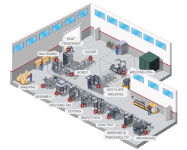Assembly line automation allows companies to meet high production demands by performing assembly processes without the intervention of a human operator and moving parts along automated process sequences. Due to the large variety of products that need to be assembled and the different processes each assembly involves, automated assembly machines are almost always custom designed, allowing companies to create a highly individualized solution. This selection guide will describe the most popular types of assembly automation equipment and the benefits they offer.
Choosing the Best Automated Assembly Machine for Your Application
Assembly line automation equipment can be classified into three main styles: factory, manufacturing, and robotic automation equipment.
- Factory automation equipment. Factory automation machines perform general movements, such as lifting or lowering.
- Manufacturing automation equipment. Manufacturing automation machines are designed to assemble a specific product and can be very fast and efficient. They usually run faster than a robotic assembly station but lack the flexibility that a robot can provide. Custom built machines are designed to run one part with a minimum number of variations. They can also perform quality control and other tasks related to general manufacturing.
- Robotic automation equipment. Robotic automation equipment involves more technical machinery that can perform assembly, material handling, painting, or other more sophisticated tasks. This equipment can be very flexible; once a robot is programmed, it can switch from one product to another by simply selecting the product on a menu.
All types of assembly operations involve bringing together two or more parts to form a different product. Assembly operations that can be automated range from welding, stapling, gluing, screwing, pressing parts together, inserting, riveting, clinching, and many more operations that join components. To facilitate these operations, various types of automated assembly machines can be used, including:
- Marking systems: In the current manufacturing ecosystem, traceability of assembly components is common and sometimes mandatory. Marking systems (laser marking, ink jet & micro percussion) enable manufacturers to add important pieces of information to parts to facilitate product traceability in the production line.
- Testing systems: Automated testing can be performed during the assembly process or at the end of the line when the assembly is complete. All types of testing can be automated, including functional tests, dimensional inspection, detection of components, noise detection, functional tests, and many more operations that guarantee that the final assembled product meets the required quality criteria.
- Leak detection systems: This type of automated equipment can test products after they come off the line, or it can be integrated into the production line to test products during manufacturing. In large production operations, manual sniffing, pressure decay systems, bubble checks, flow systems, or spraying can be time-consuming. Automatic leak detection solutions facilitate a much higher-detection speed with minimal operator input.
- Welding Systems: Weld quality depends on two factors: weld integrity and repeatability. Automated welding systems utilize electronic weld process controllers to ensure weld integrity. These components also allow for repeatable input parameters, resulting in consistent output. For example, we can make hot plate welding machines with different welding plates in different positions that weld at the same time.
- Pick-and-place robots: Pick-and-place robots grab incoming components from a feeding conveyor, vibratory bowl feeder, or tray and place them into the assembly or packaging containers.
- Inspection systems: Vision systems or vision sensors inspect a component’s dimensions, color, quality, and other details without physically touching them. In-line inspections offer earlier identification of defective components and significantly reduce the usage of out-of-spec parts.
- Palletizers: Using either conveyors or robotic equipment, palletizers automate the palletizing process, dramatically reducing employee injuries as well as the amount of time needed to lift and move heavy components. In manufacturing applications, robots remove products from the production line and load them onto a pallet.
Automation solutions like robotics, inspection, leak, and welding systems solve many types of production-related problems. Automated assembly machines from AMD can help you achieve a semi- or fully-automated production line that improves workplace safety while reducing manufacturing costs. We can help you create the most suitable type of assembly line automation for your business, including:
- Fully automated: Fully-automated assembly lines require little to no human interaction to complete production processes. Workers simply monitor machines for issues and replenish parts as needed.
- Semi-automated: Humans work alongside machines, performing tasks like loading parts into tooling and other fixtures or moving components from one automated station to the next.
- Lean manufacturing automation: Manufacturers only incorporate automated solutions that add the most value into the assembly process, creating the highest ROI.
- High-throughput manufacturing automation: Continuous motion technology like servo-based or mechanical cams, machine vision, and tooling are used to dramatically increase throughput speeds and reduce cycle time.
Assembly Line System Structure
To learn more about each stage in the assembly line system, hover over each section in the graphic below to reveal additional information and detailed images.
Custom Automation Equipment Solutions from AMD
As an industry leader in automation and assembly, AMD delivers state-of-the-art manufacturing solutions, including fully customized, turnkey equipment. We’ll work closely with you to ensure we deliver a custom automation solution that matches your particular requirements. Our custom automated machining offerings include:
- Assembly
- Heat treatment
- Inspection with vision systems or vision sensors
- Leak tests
- Machining
- Marking and traceability
- Packaging
- Robotic cells
- Test systems
- Welding
We design, fabricate, and install everything from a complete automated assembly line to a single manual, semi-automatic machine.
Contact Our Experts for Premium Assembly Automation Equipment
At AMD, we specialize in creating innovative technology that increases your workplace safety, profitability, and production capabilities. Our engineering team will work with you to develop a customized solution that solves your application-specific challenges. If you have any questions about our automated assembly machines, contact us. To get started on your automated solution, request a quote today.

